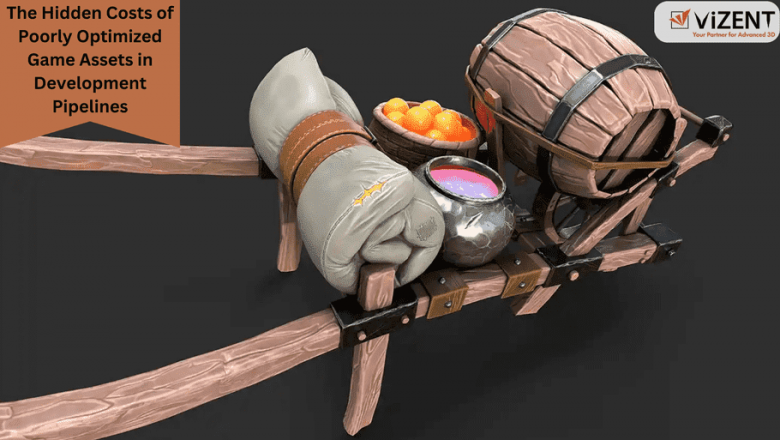views
In the competitive world of game development, ensuring that game assets are optimized is a crucial yet often overlooked aspect of the process. Poorly optimized assets can lead to a cascade of issues affecting the final product and the entire development pipeline. This blog delves into the hidden costs of unoptimized game assets and highlights how effective management of 3D modeling games, game assets, and 3D game environments can save time, money, and resources.
Understanding the Importance of Optimization
Game assets, including 3D models, textures, animations, and shaders, are the building blocks of any video game. These components must be carefully designed and optimized to ensure smooth gameplay and efficient performance. Unoptimized assets can introduce bottlenecks that compromise the gaming experience, increase development costs, and extend timelines.
Hidden Costs of Poorly Optimized Game Assets
1. Performance Issues
Unoptimized game assets can drastically reduce performance, causing lag, frame drops, or even crashes. For example, a 3D game environment with excessive polygon counts or high-resolution textures can overwhelm the hardware, particularly on devices with limited resources. These issues can result in:
-
A negative user experience
-
Poor reviews and reduced sales
-
Increased pressure on developers to release patches or updates
2. Increased Development Time
When assets are not optimized, additional time is required to troubleshoot and fix performance issues. For instance, developers may need to reduce polygon counts in 3D models or compress textures late in the development process, delaying milestones and consuming valuable resources.
3. Higher Resource Costs
Unoptimized assets consume more memory and storage, increasing the cost of server space and bandwidth for distribution. Larger file sizes also lead to longer download times, which can frustrate players and deter potential users.
4. Challenges in Cross-Platform Compatibility
Game assets designed without optimization may perform well on high-end desktops but struggle on mobile or lower-spec devices. Adapting such assets to different platforms often requires significant rework, adding to the overall development costs.
5. Poor Team Efficiency
Unoptimized assets can slow down the entire pipeline, impacting collaboration between artists, developers, and QA teams. For example, high-polygon models may cause rendering delays, hampering the productivity of other team members relying on timely asset delivery.
Strategies to Avoid the Hidden Costs
Effective optimization of 3D modeling games, game assets, and 3D game environments requires a proactive approach. Here are some strategies to mitigate the hidden costs of poor optimization:
1. Regular Asset Audits
Conducting regular audits of game assets ensures that they meet performance benchmarks. Use automated tools to identify inefficiencies, such as excessive polygon counts or oversized textures, early in the development process.
2. Implementing Level of Detail (LOD)
LOD systems dynamically adjust the quality of 3D models based on their distance from the camera. This technique reduces the rendering workload, improving performance without compromising visual fidelity.
3. Texture Compression and Atlasing
Compressing textures and using atlasing techniques minimize memory usage and reduce draw calls. For instance, combining multiple textures into a single atlas streamlines the rendering process, enhancing performance.
4. Pre-Baked Lighting and Simplified Shaders
Pre-baking lighting into textures and using simplified shaders can significantly reduce the computational load on hardware, especially for 3D game environments. These techniques are particularly effective for mobile platforms.
5. Cross-Platform Optimization
Utilize game engines like Unity or Unreal Engine, which offer built-in tools for platform-specific optimization. Tailoring assets for each platform ensures consistent performance across devices.
6. Training and Collaboration
Invest in training for team members to understand the importance of optimization and how to achieve it. Encourage collaboration between artists and developers to create assets that are visually impressive yet efficient.
Case Study: Optimizing a 3D Modeling Game
Consider a hypothetical example where a development team faces challenges with a 3D modeling game. The initial assets include high-polygon models and uncompressed textures, leading to performance issues during testing. By implementing LOD, compressing textures, and pre-baking lighting, the team reduces the asset sizes by 50% and improves frame rates by 30%. These optimizations not only enhance the user experience but also ensure timely project delivery and cost savings.
Long-Term Benefits of Asset Optimization
1. Enhanced User Experience
Optimized game assets ensure smoother gameplay, higher frame rates, and reduced loading times, resulting in a better overall experience for players.
2. Reduced Maintenance Costs
Efficient assets minimize the need for post-launch patches and updates, saving time and resources.
3. Scalability
Well-optimized assets are easier to adapt to new platforms or future updates, ensuring the game remains relevant and accessible to a broader audience.
4. Positive Brand Reputation
A polished, high-performance game enhances the studio’s reputation, attracting more players and potential partnerships.
Conclusion
The hidden costs of poorly optimized game assets can significantly impact a game’s success and the efficiency of the development pipeline. By prioritizing the optimization of 3D modeling games, game assets, and 3D game environments, developers can avoid performance issues, reduce costs, and deliver exceptional gaming experiences. Whether you’re a seasoned studio or an indie developer, investing in optimization is not just a technical requirement—it’s a strategic decision that paves the way for long-term success.






















Comments
0 comment